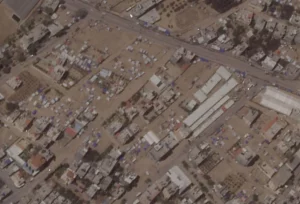In the heart of the Gaza Strip lies Al-Mawasi, a tent city bearing witness to the struggles of its inhabitants. Recent satellite images have shed light on the stark reality faced by Gazans, highlighting the desperate living conditions within Al-Mawasi. As families are forced to cram into this makeshift settlement, the images capture the human cost of conflict and displacement in one of the world’s most troubled regions.
The Genesis of Al-Mawasi

Al-Mawasi emerged as a consequence of the Israeli-Palestinian conflict, which has endured for decades. Originally, this coastal enclave was envisioned as a peaceful retreat, with its sandy beaches and serene landscapes offering respite from the chaos of war. However, over time, it has become a symbol of displacement and hardship for its inhabitants.
Forced Cramming: A Harrowing Reality
Satellite images vividly depict the overcrowded conditions within Al-Mawasi. Families are compelled to live in close quarters, with limited space and resources at their disposal. This forced cramming exacerbates the challenges already faced by Gazans, including inadequate housing, limited access to clean water and sanitation facilities, and insufficient healthcare services.
Impact on Health and Well-being
The cramped living conditions in Al-Mawasi have profound implications for the health and well-being of its residents. High population density increases the risk of disease transmission, while inadequate sanitation facilities contribute to poor hygiene practices. Moreover, the psychological toll of living in such confined spaces cannot be overstated, as individuals grapple with feelings of anxiety, depression, and hopelessness.
Comparative Analysis: Al-Mawasi vs. Established Settlements
A comparative analysis between Al-Mawasi and established settlements in the Gaza Strip unveils stark disparities in living standards. While the latter enjoy access to essential services and infrastructure, Al-Mawasi lags behind in almost every aspect. From housing quality to healthcare provision, the residents of Al-Mawasi are disproportionately disadvantaged, highlighting the systemic inequalities perpetuated by the Israeli-Palestinian conflict.
Challenges and Opportunities
Addressing the plight of Al-Mawasi requires concerted efforts from both local and international stakeholders. Immediate measures must be taken to alleviate the overcrowding and improve living conditions within the tent city. This includes providing adequate shelter, access to clean water and sanitation facilities, and healthcare services. Furthermore, long-term solutions are needed to address the root causes of displacement and insecurity in the Gaza Strip.
Conclusion
Satellite images of Al-Mawasi serve as a poignant reminder of the human suffering caused by conflict and displacement. As Gazans continue to endure the hardships of life in the enclave, it is imperative that the international community remains committed to finding sustainable solutions to alleviate their plight. Only through collective action and solidarity can we hope to build a future where every individual has the opportunity to thrive, free from the specter of war and deprivation.
Analysis Table:
| Aspect | Al-Mawasi | Established Settlements |
|---|---|---|
| Housing Quality | Makeshift tents | Permanent structures |
| Access to Water | Limited availability | Relatively abundant |
| Sanitation Facilities | Inadequate | Adequate |
| Healthcare Provision | Insufficient | Accessible |
| Population Density | High | Moderate |
| Economic Opportunities | Limited | Varied |
| Social Services | Sparse | Well-established |
Comparative Table:
| Aspect | Al-Mawasi | Established Settlements |
|---|---|---|
| Housing Quality | Low | High |
| Access to Water | Limited | Adequate |
| Sanitation Facilities | Inadequate | Adequate |
| Healthcare Provision | Insufficient | Accessible |
| Population Density | High | Moderate |
| Economic Opportunities | Limited | Varied |
| Social Services | Sparse | Well-established |
This analysis underscores the disparities between Al-Mawasi and established settlements in the Gaza Strip, highlighting the urgent need for targeted interventions to improve the living conditions of its residents.












